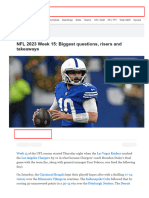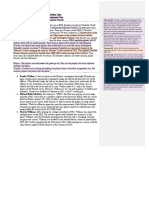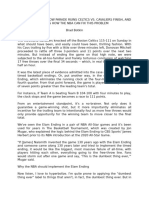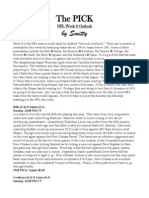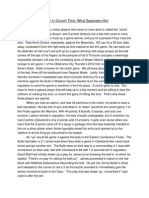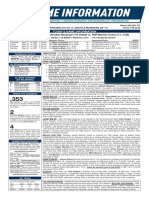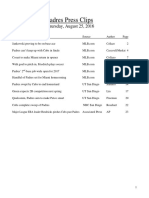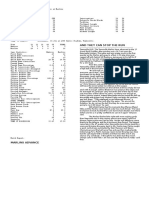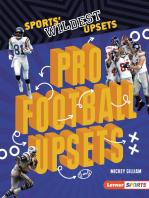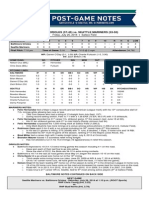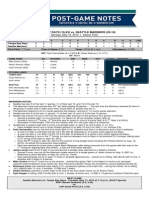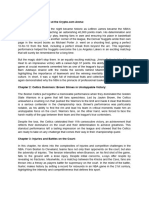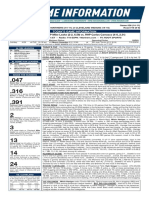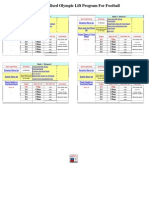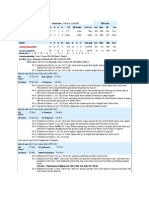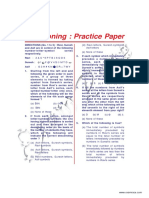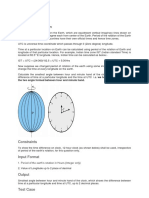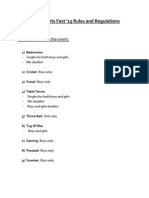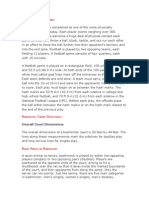Keys To Winning
Keys To Winning
Uploaded by
Tom HochhalterCopyright:
Available Formats
Keys To Winning
Keys To Winning
Uploaded by
Tom HochhalterOriginal Title
Copyright
Available Formats
Share this document
Did you find this document useful?
Is this content inappropriate?
Copyright:
Available Formats
Keys To Winning
Keys To Winning
Uploaded by
Tom HochhalterCopyright:
Available Formats
Turnovers, early deficits lead to losses By Greg Garber ESPN.
com Vince Lombardi, the celebrated coach of the Green Bay Packers whose name adorns the sterling Super Bowl trophy, said that statistics are for losers. Point taken. Still, culled from the most recent evidence -- the NFL's 2003 and 2004 regularseason statistics -- here are five leading sins of the game that are indisputably (did we mention amazingly?) and undeniably true, more often than not. Upon further review, notice that they are all, like the myriad creatures of the universe, interconnected. Here, then, is the key to the matrix you never knew existed. The percentage in parenthesis refers to the probability of losing when committing that particular sin. SINS AND MYTHS There are a bunch of clichs and truisms tied to the NFL. After crunching some numbers, we figured out which ones are deadly sins and which are myths. Truisms and untruths Five deadly sins Big-time myths Sin No. 1: Trailing after the first quarter (75 percent) While so much emphasis is placed on the fourth quarter and a team's finishing power, it's really how you start the game that matters. Teams that found themselves trailing after the first quarter lost a staggering 75 percent of their games in '03-04. If you're pressed for time, this will eliminate the need to watch the last three quarters. Seriously, teams that start slowly invariably lose. The 3-8 Arizona Cardinals have trailed at the end of the first quarter in nine of 11 games. They are 2-7 in those games (22 percent), a figure almost identical with the 23 percent achieved (if that's the word for it) over the course of the 2003 season. By the same token, teams that set the tone early wind up prevailing -- three times out of four. Take the Indianapolis Colts, for example. The 11-0 Colts have trailed only once after the first quarter. Somehow, they recovered from a 17-0 deficit in spectacular fashion against the St. Louis Rams in Week 7 to win 45-28. "Is that number right?" asked Insider Rick Spielman, who spent five seasons as the Dolphins' general manager. "That's unbelievable.
"Still, it makes sense. If you're playing with a lead, you can play solid defense and run the ball and control the clock. Your odds of winning will always be better when you can control the clock." In Week 15 of the 2003 season, all 15 teams that led after one quarter won the game. Said Green, "I guess that means the old clich about halftime adjustments isn't true. After the first 15 minutes, the game is essentially over." Sin No. 2: Losing the turnover battle (81 percent) This is a tried-and-true truism of the NFL -- what's surprising is the gravity of the number. Lose the turnover battle and you'll lose four games out of five. AP Photo/John Russell Steve McNair's fumble led to a touchdown for the Raiders in Week 8. Take the Tennessee Titans. While the Titans are 3-2 when they have fewer turnovers than their opponent, they are a dead, solid 0-5 when they have more turnovers. Tennessee committed 13 turnovers in those five games, while opposing teams lost the ball a total of only two times. That kind of hole is difficult to escape. During the first four weeks of the 2004 season, teams that won the turnover battle went a collective 43-6, a winning 87.8 percent of games. It's common sense, really. When you lose the ball, you lose a chance to score, while the opposition receives that same opportunity. At worst, it can be a 14-point swing. At best, it's usually a loss of 40 yards in field position. One turnover, quite often, can swing a game. In Sunday's game against the Tampa Bay Buccaneers, the Chicago Bears scored their only touchdown after Alex Brown hit quarterback Chris Simms and induced him to fumble on his own 1-yard line. The ensuing one-yard scoring pass from Kyle Orton to John Gilmore held up as the difference in the 13-10 victory. Good teams almost always tend to force more turnovers than they yield. Of the nine top teams in turnover margin -- Cincinnati has the league's best figure, plus-20 -- only one isn't at least three games over .500. And the 4-7 Buffalo Bills (plus-8) are actually still in playoff contention in the anemic AFC East. Sin No. 3: Allowing a 100-yard runner (75 percent)
On the five occasions the Rams (5-6) have allowed a 100-yard rusher, they are 1-4. The season began uneventfully for the Rams, who didn't allow a 100-yard runner in the first three games. Then, all hell broke loose: In three successive games, Tiki Barber (24 carries, 128 yards, 1 TD), Shaun Alexander (25-119, 2 TDs) and Edgerrin James (23-143, 3 TDs) sliced up the Rams' defense. Needless to say, all three games resulted in losses. Although Fred Taylor ran wild on St. Louis -- carrying 22 times for 165 yards -the Rams managed to hold off Jacksonville 24-21 in Week 8 to even their record at 4-4. But, after their bye week, the Rams reverted to form in Week 10. Alexander savaged the Rams for 165 yards and three touchdowns on 33 carries, and the Seahawks won another game on their way to the NFC's best record so far (9-2). In 2004, teams that featured a 100-yard rusher had a collective winning record every single week. During Weeks 6-9, the overall record was an astounding 32-1. Last year, Patriots running back Corey Dillon cleared 100 yards nine times during the regular season. New England won eight of those games; only a fourinterception game by Tom Brady (see Sin No. 2) cost them a 29-28 decision at Miami. The Patriots, you might recall, won the Super Bowl and finished with a 172 record. This year Dillon has been injured and has produced only one 100-yard game. The Patriots are 6-5 and limping toward the playoffs. Producing a 100-yard runner usually means that team has actually had the luxury of methodically handing the ball off. And thatsuggests the team is playing with a lead, which, in turn, means that passing is not a necessity. As former Ohio State coach Woody Hayes used to say, three things can happen when you throw the ball -- and two of them are bad. A turnover (see Sin No. 2) can be deadly and sometimes produce an early hole (see Sin No. 1). A dropped ball counts for nothing and also stops the clock (see Sin. No. 5). And then there is the sack, which leads us to Sin No. 4: Allowing more sacks (70 percent) When legendary Rams defensive end David "Deacon" Jones coined the term "sack" -- as in, sacking and pillaging a rival village -- he saw savage tackling of the quarterback as a means to an end. What he didn't know was that, far more often than not, allowing your quarterback to be sacked more than your opponent's means The End. Ronald Martinez/Getty Images Texans QB David Carr knows a thing or two about getting sacked.
Look no further than poor, unfortunate David Carr of the Houston Texans, the poster child of sackitis. In 54 career starts, Carr has been sacked a ludicrous 190 times (more than 3.5 per game). Houston's record in those games is 15-39 (.278). In his rookie season, he was decked 76 times -- an NFL record that is being threatened by this year's Texans. After a brutal stretch of three games against Pittsburgh, Cincinnati and Tennessee -- when Carr was sacked a total of 22 times -- the dubious record appeared in jeopardy. But now, through 11 games, with Carr suffering a league-high 50 sacks, the projection is 73. Chances are, based on more recent results, the number will wind up in the high 60s. The correlation between sacks allowed and losing is a powerful one. The Texans are 1-10, and in their only win (19-16 over the Browns) each quarterback was sacked twice. This statistic, upon reflection, fits into the matrix. The flip side of a 100-yard runner is a team desperate to catch up. When teams are forced to abandon the run, opposing defenses can rush the passer with abandon. This usually results in increased sacks and all the bad things that come with them. Teams that allowed more sacks in Week 10 in 2003 were 0-11; in Week 9 of 2004 they were 0-12. Good teams, as you might expect, protect their quarterbacks. Is it a coincidence that the 11-0 Colts have allowed Peyton Manning to be sacked only nine times -easily the league's lowest total (among full-time starting quarterbacks). Meanwhile, the Patriots' Brady has been decked 12 times in the last five games, two of them losses. It is worth noting, too, that the Texans won their only game by avoiding Sins. No. 2 and No. 3 and, instructively, Sin No. 5. Sin No. 5: Losing time of possession (67 percent) Possession, they say, is nine-tenths of the law. But in today's NFL you'll have to settle for seven-tenths. OK, to split hairs, 6.7-tenths. The Buccaneers, by today's air-it-out standards, are a conservative team. Watching them, you might think it's still 1950. Head coach Jon Gruden drafted Cadillac Williams in the first round so, along with fullback Mike Alstott, he could keep pounding teams into submission while the defense did its muscular job. So far, it's worked out pretty well for the Bucs. They have outscored opponents by a paltry 20 points, but at 7-4 they've won three more games than they've lost. Their narrow margin of error can be seen in the time-of-possession statistics. In
11 games, they have held the ball an average of 2 minutes and 40 seconds longer than opponents. The Bucs are 5-2 when they win time of possession; 2-2 when they don't. Sunday's 13-10 loss to Chicago underlines the fragile dynamic. The Bears possessed the ball for all of six more seconds than the Bucs -- and won. Scan the 2005 team numbers and you'll find the usual suspects at the top of the list. Dallas (33:30) leads the NFL with Kansas City (32:26) and Denver (32:21) second and third, respectively. Those teams -- all in playoff contention -- are guided by old-school coaches Bill Parcells, Dick Vermeil and Mike Shanahan, who have always employed a run-first, pass-second philosophy. There's one other thing they all have in common: Super Bowl rings. Greg Garber is a senior writer for ESPN.com.
You might also like
- Nebraska Football Strength & Conditioning Summer ProgramDocument26 pagesNebraska Football Strength & Conditioning Summer ProgramBuzzard951111100% (2)
- Strength Conditioning Manual KILGORE COLLEGE Football 2011Document70 pagesStrength Conditioning Manual KILGORE COLLEGE Football 2011Tom Hochhalter100% (3)
- Strength & Conditioning - Concordia Univ 2011Document19 pagesStrength & Conditioning - Concordia Univ 2011Tom Hochhalter100% (5)
- Workout - Sheet - Football Off-Season Strength TrainingDocument16 pagesWorkout - Sheet - Football Off-Season Strength TrainingTom Hochhalter100% (1)
- Workout - Sheet - Football 30-Week Off-Season Training Week 5-9Document9 pagesWorkout - Sheet - Football 30-Week Off-Season Training Week 5-9Tom HochhalterNo ratings yet
- WWW Espn in NFL Story Id 39099854 NFL Week 15 2023 Questions Risers Fallers TaDocument6 pagesWWW Espn in NFL Story Id 39099854 NFL Week 15 2023 Questions Risers Fallers Tawebincome25No ratings yet
- Sports News Lead Campus JournalismDocument8 pagesSports News Lead Campus JournalismLea BalquinDivinagracia Dumago MartinezDelatorreNo ratings yet
- Daily Debate: Soccer Faces West Virginia in Big 12 MatchupDocument1 pageDaily Debate: Soccer Faces West Virginia in Big 12 MatchupThe University Daily KansanNo ratings yet
- h8Document12 pagesh8Rujean Romy Porteza GuisandoNo ratings yet
- 9 - Sports 3Document1 page9 - Sports 3api-232759423No ratings yet
- g7Document11 pagesg7Rujean Romy Porteza GuisandoNo ratings yet
- UWRTAssgn 1Document8 pagesUWRTAssgn 1Emerson CreechNo ratings yet
- Football's Greatest Hail Mary Passes and Other Crunch-Time HeroicsFrom EverandFootball's Greatest Hail Mary Passes and Other Crunch-Time HeroicsNo ratings yet
- MISERABLE FREE-THROW PARADE RUINS CELTICS VS. CAVALIERS FINISH, AND HERE'S HOW THE NBA CAN FIX THIS PROBLEMDocument3 pagesMISERABLE FREE-THROW PARADE RUINS CELTICS VS. CAVALIERS FINISH, AND HERE'S HOW THE NBA CAN FIX THIS PROBLEMIsaac Joshua AganonNo ratings yet
- The PICK Week 8Document6 pagesThe PICK Week 8Gerry SchmidtNo ratings yet
- Picksix NFL Week 14Document3 pagesPicksix NFL Week 14api-243170353No ratings yet
- Lebron in Crunch Time: What Separates HimDocument2 pagesLebron in Crunch Time: What Separates Himapi-288111361No ratings yet
- Midwest 12 Midseason Report: Jeffalo Bills (Record: 7 - 1)Document9 pagesMidwest 12 Midseason Report: Jeffalo Bills (Record: 7 - 1)Anonymous y9s4O8lNo ratings yet
- Linspired, Kids Edition: The Jeremy Lin Story by Jesse Florea, Mike YorkeyDocument23 pagesLinspired, Kids Edition: The Jeremy Lin Story by Jesse Florea, Mike YorkeyZondervanNo ratings yet
- Week 1Document5 pagesWeek 1api-241936601No ratings yet
- Green & Gold Express - Week 13Document16 pagesGreen & Gold Express - Week 13WolfRiverMediaNo ratings yet
- Saints Edge Eagles 26-24 in NFC Wild-Card GameDocument4 pagesSaints Edge Eagles 26-24 in NFC Wild-Card Gamejoblessslogan5906No ratings yet
- Game Notes 8-14 vs. MontgomeryDocument10 pagesGame Notes 8-14 vs. MontgomeryChris HarrisNo ratings yet
- Chiefs Vs Broncos HighlightsDocument5 pagesChiefs Vs Broncos Highlightstrendingbloggers08No ratings yet
- Week 14 Game ReviewsDocument9 pagesWeek 14 Game ReviewsdeanwebleyNo ratings yet
- Tough StretchDocument1 pageTough StretchTrevor DenasaNo ratings yet
- News Excellence Sept 20 B5Document1 pageNews Excellence Sept 20 B5Contest PagesNo ratings yet
- 2024 NFL Win Total Projections for All 32 Teams Experts React to Our Model - The AthleticDocument1 page2024 NFL Win Total Projections for All 32 Teams Experts React to Our Model - The AthleticSebastian AlvarezNo ratings yet
- Wild Card Weekend PreviewDocument3 pagesWild Card Weekend PreviewGerry SchmidtNo ratings yet
- The PICK Week 6Document7 pagesThe PICK Week 6Gerry SchmidtNo ratings yet
- GNG 151030 004Document1 pageGNG 151030 004WolfRiverMediaNo ratings yet
- Today'S Game Information: Starting Pitchers: RHP Christian Bergman ( 18 Debut) vs. RHP Bartolo Colon (1-1, 3.32)Document8 pagesToday'S Game Information: Starting Pitchers: RHP Christian Bergman ( 18 Debut) vs. RHP Bartolo Colon (1-1, 3.32)MarinersPRNo ratings yet
- Chiefs Vs Dolphins Live Stream Reddi TVCDocument4 pagesChiefs Vs Dolphins Live Stream Reddi TVCvcbvcbNo ratings yet
- Padres Press Clips 08.25.16 Vpr3k0v9Document23 pagesPadres Press Clips 08.25.16 Vpr3k0v9Collin WoomerNo ratings yet
- Gameday PreviewDocument2 pagesGameday PreviewThe University Daily KansanNo ratings yet
- NFL Game Predictions - Week 2Document5 pagesNFL Game Predictions - Week 2Gerry SchmidtNo ratings yet
- Springfieldnewsleader 20160518 d03Document1 pageSpringfieldnewsleader 20160518 d03api-261541986No ratings yet
- Green & Gold Express 1002Document16 pagesGreen & Gold Express 1002WolfRiverMediaNo ratings yet
- Built Different: The Boston Celtics' Historic Run to the 2024 NBA ChampionshipFrom EverandBuilt Different: The Boston Celtics' Historic Run to the 2024 NBA ChampionshipNo ratings yet
- LakeviewDocument1 pageLakeviewapi-230544978No ratings yet
- 1121 NFL PicksDocument1 page1121 NFL Picksrstroope3460No ratings yet
- News Excellence June 18 B4Document1 pageNews Excellence June 18 B4Contest PagesNo ratings yet
- Hunters at MarlinsDocument4 pagesHunters at MarlinsAnonymous LDxI4IdRNo ratings yet
- From the Outside: My Journey Through Life and the Game I LoveFrom EverandFrom the Outside: My Journey Through Life and the Game I LoveRating: 4.5 out of 5 stars4.5/5 (4)
- 04.10.13 Mariners Minor League ReportDocument10 pages04.10.13 Mariners Minor League ReportRyan DivishNo ratings yet
- Green & Gold Express1211Document16 pagesGreen & Gold Express1211WolfRiverMediaNo ratings yet
- 1021 College FB FrontDocument1 page1021 College FB FrontjondavidreedNo ratings yet
- Rules vs. Rules-Within-Rules vs. Getting It RightDocument4 pagesRules vs. Rules-Within-Rules vs. Getting It RightSotelo JoseNo ratings yet
- Midseason ReportDocument4 pagesMidseason ReportZachary Morgan JrNo ratings yet
- At Long Last: The Texas Rangers' Historic Run to the 2023 World SeriesFrom EverandAt Long Last: The Texas Rangers' Historic Run to the 2023 World SeriesNo ratings yet
- Westbrook, Thunder Put Warriors On Brink of EliminationDocument1 pageWestbrook, Thunder Put Warriors On Brink of EliminationRomeo Jr SibullasNo ratings yet
- Baltimore Orioles (57-45) vs. Seattle Mariners (53-50) : Friday, July 25, 2014 Safeco FieldDocument2 pagesBaltimore Orioles (57-45) vs. Seattle Mariners (53-50) : Friday, July 25, 2014 Safeco FieldRyan DivishNo ratings yet
- Wisconsin Goats: Just Substitute These Duke Players Throw Forearm ShiversDocument4 pagesWisconsin Goats: Just Substitute These Duke Players Throw Forearm Shiversleroy_bridges13No ratings yet
- Eagles News: Philadelphia Ranks Last in Touchdown Passes Longer Than 15 YardsDocument5 pagesEagles News: Philadelphia Ranks Last in Touchdown Passes Longer Than 15 YardsJayNo ratings yet
- TAMPA BAY RAYS (16-23) vs. SEATTLE MARINERS (20-18) : Monday, May 12, 2014 Safeco FieldDocument2 pagesTAMPA BAY RAYS (16-23) vs. SEATTLE MARINERS (20-18) : Monday, May 12, 2014 Safeco FieldRyan DivishNo ratings yet
- All The StressDocument6 pagesAll The Stressapi-132169236No ratings yet
- What On Earth Was ThatDocument3 pagesWhat On Earth Was ThatjalbaNo ratings yet
- Today'S Game Information: Starting Pitchers: RHP Mike Leake (2-2, 6.59) vs. RHP Carlos Carrasco (4-0, 2.31)Document8 pagesToday'S Game Information: Starting Pitchers: RHP Mike Leake (2-2, 6.59) vs. RHP Carlos Carrasco (4-0, 2.31)MarinersPRNo ratings yet
- Drill Sheet Ladder Drill CollectionDocument9 pagesDrill Sheet Ladder Drill CollectionTom HochhalterNo ratings yet
- Sprint Workouts 16-Week CycleDocument16 pagesSprint Workouts 16-Week CycleTom HochhalterNo ratings yet
- Drill - Sheet - Self Stretching For Weight LiftingDocument2 pagesDrill - Sheet - Self Stretching For Weight LiftingTom HochhalterNo ratings yet
- Conditioning For FootballDocument4 pagesConditioning For FootballTom HochhalterNo ratings yet
- Football Tempo RunsDocument2 pagesFootball Tempo RunsTom Hochhalter100% (1)
- Drill Sheet Cone Agility DrillsDocument10 pagesDrill Sheet Cone Agility DrillsTom HochhalterNo ratings yet
- Football SpeedDocument2 pagesFootball SpeedTom HochhalterNo ratings yet
- Drill - Sheet - Back Peddle Sprint DrillDocument1 pageDrill - Sheet - Back Peddle Sprint DrillTom Hochhalter100% (1)
- Football Game SimulationDocument2 pagesFootball Game SimulationTom HochhalterNo ratings yet
- Drill - Sheet - Cone Agility Drill 2 For Sport - 1397608848547Document1 pageDrill - Sheet - Cone Agility Drill 2 For Sport - 1397608848547Tom HochhalterNo ratings yet
- Workout - Sheet - Football 30-Week Off-Season Training Week25-30Document10 pagesWorkout - Sheet - Football 30-Week Off-Season Training Week25-30Tom Hochhalter100% (1)
- Workout - Sheet - Football Advanced Off-Season Strength TrainingDocument18 pagesWorkout - Sheet - Football Advanced Off-Season Strength TrainingTom Hochhalter100% (1)
- Workout - Sheet - Football In-Season Squat ProgramDocument2 pagesWorkout - Sheet - Football In-Season Squat ProgramTom HochhalterNo ratings yet
- Workout - Sheet - Football 30-Week Off-Season Training Week15-19Document9 pagesWorkout - Sheet - Football 30-Week Off-Season Training Week15-19Tom HochhalterNo ratings yet
- Football Strength & SpeedDocument2 pagesFootball Strength & SpeedTom HochhalterNo ratings yet
- Workout - Sheet - Football Clean and Jerk ProgramDocument6 pagesWorkout - Sheet - Football Clean and Jerk ProgramTom HochhalterNo ratings yet
- Football Defensive BackDocument16 pagesFootball Defensive Backzaid786786No ratings yet
- Workout - Sheet - Football 30-Week Off-Season Training Week20-24Document9 pagesWorkout - Sheet - Football 30-Week Off-Season Training Week20-24Tom HochhalterNo ratings yet
- Workout - Sheet - Football In-Season Strength TrainingDocument12 pagesWorkout - Sheet - Football In-Season Strength TrainingTom HochhalterNo ratings yet
- Workout - Sheet - Football Mixed Olympic Lift ProgramDocument6 pagesWorkout - Sheet - Football Mixed Olympic Lift ProgramTom HochhalterNo ratings yet
- Summer Strength ManualDocument124 pagesSummer Strength Manualdescooksey100% (2)
- Seton Hill University Strength & Conditioning Manual 2008Document44 pagesSeton Hill University Strength & Conditioning Manual 2008Tom HochhalterNo ratings yet
- Toledo Rocket ManualDocument20 pagesToledo Rocket ManualTom HochhalterNo ratings yet
- ATF Training Plan Week 1Document1 pageATF Training Plan Week 1Tom HochhalterNo ratings yet
- Athlete Training Formula Phase 1 AccumulationDocument4 pagesAthlete Training Formula Phase 1 AccumulationTom HochhalterNo ratings yet
- Hybrid West Coast Offense Cover Tampa 2 Specs PDFDocument7 pagesHybrid West Coast Offense Cover Tampa 2 Specs PDFSteve WilsonNo ratings yet
- Players RDocument1 pagePlayers Rstu7170No ratings yet
- Gridiron Football 8Document6 pagesGridiron Football 8William BellNo ratings yet
- MS Dhoni: Suresh RainaDocument2 pagesMS Dhoni: Suresh Rainarajashekarb9No ratings yet
- Sports Reporter: Thomas Larsen Wins Kuwait International OpenDocument8 pagesSports Reporter: Thomas Larsen Wins Kuwait International OpenSportsReporterNo ratings yet
- Reasoning Solved Paper 1Document14 pagesReasoning Solved Paper 1SHEKHARNo ratings yet
- The Grass Rink July 2018 Volume 12 Issue 2Document8 pagesThe Grass Rink July 2018 Volume 12 Issue 2api-241553699No ratings yet
- Class-XII Project On 'An Interview of An Eminent Person'Document22 pagesClass-XII Project On 'An Interview of An Eminent Person'Gourab Gorai100% (1)
- History of Bowling AssignmentDocument16 pagesHistory of Bowling AssignmentDaizLee AhmadNo ratings yet
- QuestionDocument8 pagesQuestiondon't know100% (1)
- July 8 - 14, 2015 Sports ReporterDocument8 pagesJuly 8 - 14, 2015 Sports ReporterSportsReporterNo ratings yet
- Team RecordsDocument24 pagesTeam Recordsapi-262446627No ratings yet
- Cricket Score Sheet 3Document1 pageCricket Score Sheet 3Sankar SriNo ratings yet
- South Carroll OffenseDocument40 pagesSouth Carroll OffenseKeys To Success100% (1)
- Job Design: Role of Wicket-KeeperDocument3 pagesJob Design: Role of Wicket-KeeperManju MohanNo ratings yet
- Workload Monitoring Fast Bowl NOTESDocument33 pagesWorkload Monitoring Fast Bowl NOTESCJ ClarkNo ratings yet
- India Schedule 2014 - InD International Cricket Fixtures 2014-2015 - Test, ODI, Twenty20 MatchesDocument2 pagesIndia Schedule 2014 - InD International Cricket Fixtures 2014-2015 - Test, ODI, Twenty20 MatchesManisankar DhabalNo ratings yet
- Rules and RegulationsDocument5 pagesRules and Regulationsapi-273966122No ratings yet
- Roshni Issue 33: Jan 3 - Jan 18Document16 pagesRoshni Issue 33: Jan 3 - Jan 18Anonymous ZjF6TYbNo ratings yet
- Trophies: For Titles Where The Winners GoDocument180 pagesTrophies: For Titles Where The Winners GoAgon KarakashiNo ratings yet
- Coaching The No-Huddle OffenseDocument179 pagesCoaching The No-Huddle OffensePablo Velasco100% (8)
- Basic Rules of FootballDocument6 pagesBasic Rules of FootballAnil Singh MaviNo ratings yet
- Sri Lanka Vs India, 1st ODI - Live Cricket Score, CommentaryDocument3 pagesSri Lanka Vs India, 1st ODI - Live Cricket Score, CommentarySabyasachi GhoshNo ratings yet
- Ashes Manual ENG PCDocument6 pagesAshes Manual ENG PCAtul Bramhankar0% (1)
- Cricket Tournament RulesDocument17 pagesCricket Tournament RulesZee FishNo ratings yet
- Across The Line Agricultural Shot: Pitch Bat Slog Innings Batsmen Dismissed Batting BowlingDocument17 pagesAcross The Line Agricultural Shot: Pitch Bat Slog Innings Batsmen Dismissed Batting BowlingGopsvsNo ratings yet
- ICC World Cup Match 14: India Beat Australia by 36 Runs, HighlightsDocument2 pagesICC World Cup Match 14: India Beat Australia by 36 Runs, HighlightsSaumya SaxenaNo ratings yet
- All Out Cricket June 2010 SampleDocument21 pagesAll Out Cricket June 2010 SampleAll Out Cricket100% (1)
- ITCF India Players Registration Form PDFDocument1 pageITCF India Players Registration Form PDFAbhinav SinghNo ratings yet
- DodgeballDocument12 pagesDodgeballCarlo Mercado100% (1)





